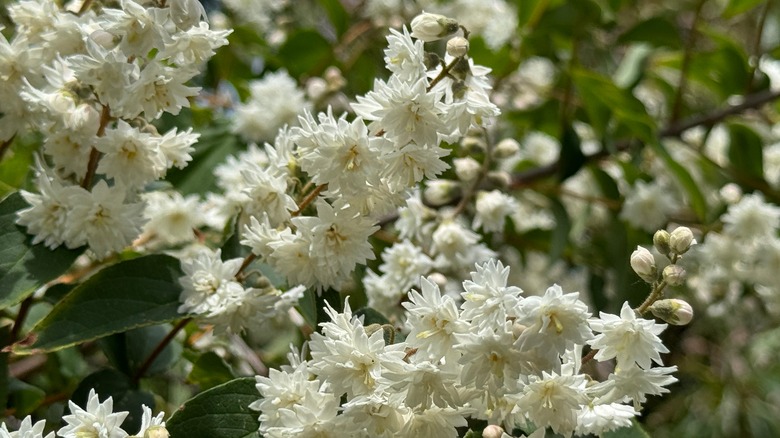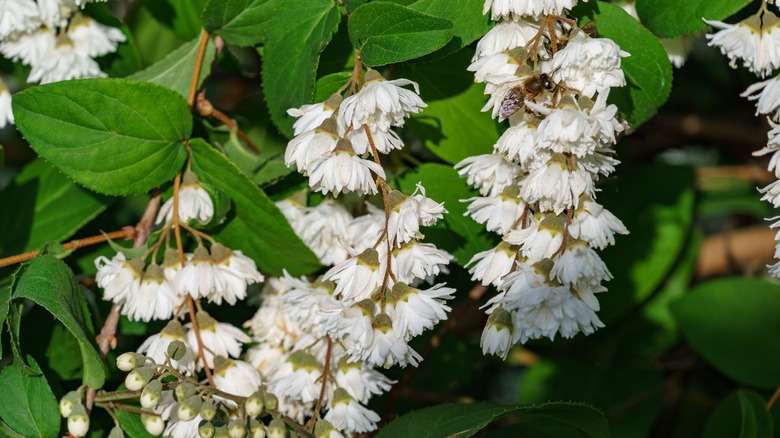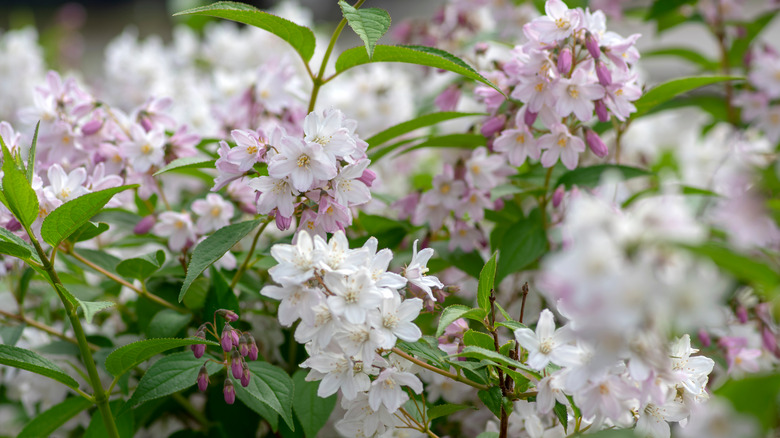The Popular Flowering Deutzia Has Invasive Tendencies. Here's What We Know
Do you have a lovely flowering deutzia growing in your yard or are you planning to grow one? This deciduous shrub is in the Hydrangeacea family and is prized for its beautiful flowers and low-maintenance requirements. There are over 60 species in the genus, and the plant is native to East Asia, Japan, and Northeast China. Due to its popularity, it's now widely grown in the U.S. and enjoyed by gardeners in zones 5 through 8. While not all non-native plants are going to be invasive, fuzzy pride-of-Rochester deutzia is an invasive species in North Carolina and throughout the Mid-Atlantic.
Deutzia scabra, or fuzzy pride-of-Rochester, is the main example of a cultivar that has been identified as having invasive tendencies. This is a vigorously growing shrub that can reach a height of up to 10 feet and a spread of up to 8 feet. It features white star-shaped flowers that result in lots of viable seeds, which will germinate readily. The shrub has self-seeding tendencies, which adds to its potential as an invasive. When the seeds spread to neighboring gardens, forests, nature reserves, and other bushland areas, this type of deutzia will become established and has the tendency to crowd out native species.
Here's what you need to know about deutzia's invasive nature
The problem with deutzia is that it can grow in a variety of soil types and can handle various growing conditions, such as full sun or part shade. Its self-seeding capability means that it can be difficult to confine this plant just to your yard. Apart from being regarded as an invasive species in North Carolina and throughout the Mid-Atlantic, fuzzy pride-of-Rochester deutzia has also been found growing in state parks in Kentucky. According to the Invasive Plant Atlas of the United States, deutzia is also one of 40 species regarded as being invasive in the Rock Creek National Park in Washington, D.C.
Once this species of deutzia becomes established in areas such as open woodlands, shaded forests, and even neighboring yards and gardens, it will compete for both moisture and nutrients in the soil with the other plants that are growing in these areas. Plus, its spreading habit means that it can easily crowd out these other garden plants and native species. While you can limit the spread of many invasive plants by deadheading them as soon as flowers have bloomed, or trying other clever ways to keep invasive plants from spreading, this is not always practical for deutzia. So, what's the solution?
Consider growing a non-invasive variety
If you're environmentally conscious and want to ensure that you limit the destructive effect that your garden plants could have on the natural environment, look for alternatives. You can find non-invasive species within the same genus. One good example is Deutzia gracilis or slender deutzia. This is a lovely shrub that only grows to a maximum height of 2 to 5 feet with a similar spread. It features masses of small, white flowers that are fragrant and can add a touch of class to your garden. The University of New Hampshire lists this species as a non-invasive alternative to Japanese barberry, which is another invasive species to avoid planting in your garden. While the slender deutzia will still produce masses of gorgeous blooms, its limited spreading habit means that even if it does escape into forests or nature reserves, it's not as likely to crowd out the native species that are growing there.
Slender deutzia will grow in zones 5 through 8 and prefers moderately moist soil that is free draining. It grows best in a sunny position, but can also handle a little shade. Like its more invasive cousin, it's a low-maintenance plant and produces its lovely flowers over spring and summer. Other smaller growing varieties and cultivars of deutzia that you might like to consider are Deutzia x rosea Nikko Blush with masses of dainty pink blooms or deutzia Raspberry Sundae which is a hybrid cultivar.


